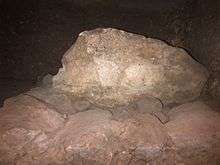Matzevah
Matzevah (Hebrew: מצבה; "pillar" or "sacred pillar") is a sacred pillar in the Hebrew Bible. It is also a headstone or tombstone marking a grave.
Biblical narrative
According to Genesis 28:22 Jacob says "this matzevah shall be God's House" and in Genesis 31:13 Yahweh says to Jacob "I am the God of Bethel where you anointed a pillar (matzevah), where you made a vow to Me..." According to Genesis 35:20 "And Jacob set a pillar upon her grave: that is the pillar of Rachel's grave unto this day." Use of the exclusive word can be found in Genesis 28:18, 28:22, 31:13, 31:45, 35:14, 35:20, Exodus 24:4, Deuteronomy 16:22 and Hosea 3:4.
Archaeological prototype

The oldest remaining example of a standing matzevah exists in Jerusalem. The middle Bronze Age excavation was led by archaeologists Ronny Reich and Eli Shukron at the time of its discovery in 2009. The matzevah is located on the bedrock of a high ridge in which various archaeological features in adjacent rooms are carved out of the natural bedrock.
The construction is a single erect slab (approximately 2–3 cm thick), erected between rocks that are tightly held together by some as yet unknown construction. This matzevah does not mark a grave site, instead site indications suggest the area was used for sacrificial purposes. Features include an olive and grain press as well as platforms for animal sacrifice and supported by the discovery of large quantities of animal bones in the deep cisterns and pools immediately below the upper ridge.
Modern tombstones or headstones, generally associated with ritual markers of grave sites may have been established from this similar shaped ancient matzevah prototype.
Location
The eastern slopes of the City of David have been associated with the work of archaeologists Kathleen Kenyon and Eilat Mazar referred to as the Millo, roughly translated as a 'land fill'. Comments attributed to Eli Shukron indicate the soft land fill[1] may have been purposely placed to bury and preserve the upper ridge, protecting it and the relatively delicate matzevah from the multiple marauding attacks on the ancient city of Jerusalem over thousands of years. The area was mapped during the 1909 expedition of Montagu Brownlow Parker, 5th Earl of Morley.[2]
The matzevah is located on the high ridge on neck of the mountain thought to be Mount Moriah on which the biblical accounts of the grandfather, father and son trilogy Abraham, Isaac and Jacob are often said to have taken place. The specific location[3] at which the biblical narrative of Jacob is said to have converged is the site of the sacrifice of Isaac (the biblical "land of Moriah"), which is traditionally identified with Mount Moriah is ancient Jerusalem.[4][5]